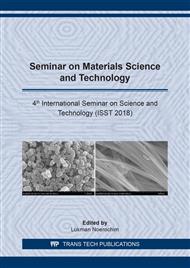[1]
C. Giri, L. Ochieng, L.L. Tieszen, Z. Zhu, A. Singh, T. Loveland, J. Masek, N. Duke, Status and distribution of mangrove forests of the world using earth observation satellite data, Glob. Ecol. Biogeogr. 20 (2011) 154–159.
DOI: 10.1111/j.1466-8238.2010.00584.x
Google Scholar
[2]
M.L. Wilkie and S. Fortuna, Status and Trends in Mangrove Area Extent Worldwide, Food and Agriculture Organization (FAO), Rome, (2003).
Google Scholar
[3]
W. Giesen, S. Wulffraat, M. Zieren, L. Scholten, Mangrove Guidebook for Southeast Asia, Food and Agriculture Organization (FAO) of the United Nations/Wetlands International Dharmasarn Co.Ltd, Bangkok, (2006).
Google Scholar
[4]
K.H. Ling, C.T. Kian, and T.C. Hoon, A Guide To Medicinal Plants, World Scientific Publishing Co. Pte. Ltd, Singapore, (2006).
Google Scholar
[5]
A.C. Dweck, T. Meadows, Tamanu (Calophyllum inophyllum) – the African, Asian, Polynesian and Pacific Panacea, Int. J. Cosmet. Sci. 24 (2002) 1-8.
DOI: 10.1046/j.1467-2494.2002.00160.x
Google Scholar
[6]
D.F. Susanto, H.W. Aparamarta, A. Widjaja, and S. Gunawan, Identification of phytochemical compounds in Calophyllum inophyllum leaves. Asian Pac. J. Trop. Biomed. 7 (2017) 773–781.
DOI: 10.1016/j.apjtb.2017.08.001
Google Scholar
[7]
J. Hemavathy, J.V. Prabhakar, Lipid composition of Calophyllum inophyllum kernel, J. Am. Oil Chem. Soc. 67 (1990) 955–957.
DOI: 10.1007/bf02541856
Google Scholar
[8]
S.B. Chavan, R.R. Kumbhar, R.B. Deshmukh, Callophyllum inophyllum Linn (honne,) Oil, A source for biodiesel production, 3 (2013) 24–31.
Google Scholar
[9]
A.E. Atabani and S.César, Calophyllum inophyllum L . – A prospective non-edible biodiesel feedstock. Study of biodiesel production, properties, fatty acid composition, blending and engine performance, Renew. Sustain. Energy Rev. 37 (2014) 644–655.
DOI: 10.1016/j.rser.2014.05.037
Google Scholar
[10]
I.A. Ajayi, Comparative study of the fatty acid composition of some seed oils from Nigeria, African J. Plant Sci. Biotechnol. 3 (2009) 59–62.
Google Scholar
[11]
W.F. Tinto, T.O. Elufioye, J. Roach, Waxes, in S. Badal, R. Delgoda (Eds), Pharmacognosy: Fundamental, Application and Strategy, Elsevier Inc., London, 2017, pp.443-452.
DOI: 10.1016/b978-0-12-802104-0.00022-6
Google Scholar
[12]
E. Endlein, K.H. Peleikis, Natural waxes - properties, compositions, and applications, Int. J. Appl. Sci. 4 (2011) 1–8.
Google Scholar
[13]
S.R. Vali, Y.H. Ju, T.N.B. Kaimal, Y.T. Chern, A process for the preparation of food-grade rice bran wax and the determination of its composition, J. Am. Oil Chem. Soc. 82 (2005) 57–64.
DOI: 10.1007/s11746-005-1043-z
Google Scholar
[14]
S. Gunawan, S.R. Vali, Y.H. Ju, Purification and identification of rice bran oil fatty acid steryl and wax esters, J. Am. Oil. Chem. Soc. 83 (2006) 1–8.
DOI: 10.1007/s11746-006-1225-8
Google Scholar
[15]
L. Huynh, Q. Do, N.S. Kasim, Y.H. Ju, Isolation and analysis of wax esters from activated sludge, Bioresour. Technol., 102 (2011) 9518–9523.
DOI: 10.1016/j.biortech.2011.08.005
Google Scholar
[16]
H.W. Aparamarta, T. Saputra, A. Claratika, Y. H. Ju, and S. Gunawan, Separation and purification of triacylglycerols from nyamplung (Calophyllum inophyllum) oil by batchwise solvent extraction, Ind. Eng. Chem. Res. 55 (2016) 3113–3119.
DOI: 10.1021/acs.iecr.5b04877
Google Scholar
[17]
M. Kellens, M. Hendrix, Fractionation, in R.D. O'Brien, W.E. Farr, Wan, P.J (Eds.), Introduction to Fats and Oils Technology, second ed, AOCS press, Champaign, 2000, p.194–207.
Google Scholar
[18]
H.W. Aparamarta, L. Qadariyah, S. Gunawan, Y.H. Ju, Separation and identification of fatty acid in triacylglycerol isolated from Calophyllum inophyllum Oil, ARPN J. Eng. Appl. Sci. 13 (2018) 442–451.
Google Scholar
[19]
P. C. Sadek, The HPLC Solvent Guide 2nd Edition. Wiley of Interscience, New York, (2002).
Google Scholar
[20]
S. Gunawan, H. W. Aparamarta, and Y.-H. Ju, Utilization Of Calophyllum Inophyllum Seed Oil, in N.K.D. Hong (Ed.), Seed Oil: Production, Uses, and Benefits, Nova Science Publishers, Inc., New York, 2018, p.111–143.
Google Scholar


